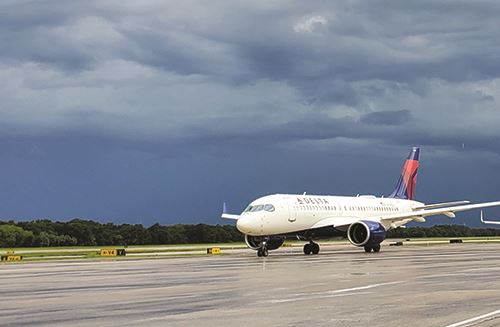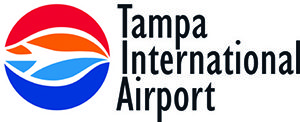While many airfield safety programs focus on runways, Tampa International (TPA) recently finished a $78,500 project that honed in on its apron area. The Florida airport established a well-defined route specifically designed to decrease the speed of ground service vehicles and help keep them a safe distance from parked and taxiing aircraft.
While many airfield safety programs focus on runways, Tampa International (TPA) recently finished a $78,500 project that honed in on its apron area.
 The Florida airport established a well-defined route specifically designed to decrease the speed of ground service vehicles and help keep them a safe distance from parked and taxiing aircraft. The roughly 2.3-mile apron service-roadway system also is expected to limit the spread of foreign object debris such as pieces of luggage tags and nuts and bolts by making it easier to spot and collect.
The Florida airport established a well-defined route specifically designed to decrease the speed of ground service vehicles and help keep them a safe distance from parked and taxiing aircraft. The roughly 2.3-mile apron service-roadway system also is expected to limit the spread of foreign object debris such as pieces of luggage tags and nuts and bolts by making it easier to spot and collect.
Jordan Biegler, senior manager of airfield operations and emergency management, notes that the two-lane road will help keep workers who drive fuel trucks, tugs, catering trucks and other service vehicles on a safe path during inclement weather. “This dedicated apron road enhances our already established low-visibility operation plan,” he notes.
|
Project: Dedicated Apron Service Road Location: Tampa (FL) Int’l Airport Owner/Operator: Hillsborough County Aviation Authority 2020 Operations: About 166,000 Approx. Project Cost: $78,500 ($69,000 for design, $9,500 for materials) Funding: General airport revenue
Design/Project Management: Roadway Length: About 2.3 miles Markings: 117,976 ft. Painted: March 2020 through July 2021 Labor: 1,112 hours (in-house maintenance workers) Materials Used: 400 gallons paint; 3,400 lbs. reflective glass beads Key Benefits: Enhances airfield safety through better speed control, more predictable driving paths for ground service vehicles; facilitates separation between vehicles & aircraft; reduces spread of foreign object debris; reduces distraction of unpredictable vehicle traffic for pilots |
The new road, which was completed in July, is expected to be popular with pilots because it will minimize unpredictable traffic from service vehicles. Previously, ground vehicle drivers tended to take the most convenient paths when traveling on the apron. At times, however, they drove vehicles into areas on the apron where pilots might not expect traffic.
“Before this, we basically had a huge piece of concrete airside apron [335,000 square yards] with no defined path,” Biegler explains. “It was left up to drivers to see and avoid aircraft.”
Of note, TPA had not experienced any major vehicle accidents on its apron, and FAA does not require airports to create such apron roadways for ground service vehicles. The Hillsborough County Aviation Authority, which owns and operates TPA, proactively initiated the project.
“As we’ve implemented safety management programs, we felt there was a gap here—an area where we could enhance overall safety,” Biegler explains. “With a clearly delineated path, drivers aren’t confused about where they can go.”
Challenging Design
The airport hired RS&H Inc. to evaluate its apron traffic and propose an optimum route for service vehicles.
“The major consideration was understanding all the separation requirements for aircraft, both while parked and while taxiing,” says Chris Ryle, the RS&H senior aviation engineer who served as project manager.
Biegler notes that it was essential for the road to not route service vehicles too close to any aircraft tails or wings. “The biggest challenge was that some areas of the commercial terminal apron just aren’t designed to accommodate a roadway system like this,” he adds. “So we had to be very deliberate about where we put it so it didn’t infringe on wingtip clearances along taxi routes and the tails of airplanes parked at gates. It was kind of a tightrope walk.”
Engineers considered what vehicles would use the road and the turning radii they require. They also factored in federal and state roadway standards.
 “It was a very intricate process to work within the existing site constraints and meet all the required criteria for aircraft and vehicles,” Ryle says. “If you’re designing a brand new airfield layout, you can provide all the spatial requirements for object-free areas, service roads and parked aircraft. But we had to work with a geometric layout for a service road within existing constraints…and resolve all the issues stemming from that.”
“It was a very intricate process to work within the existing site constraints and meet all the required criteria for aircraft and vehicles,” Ryle says. “If you’re designing a brand new airfield layout, you can provide all the spatial requirements for object-free areas, service roads and parked aircraft. But we had to work with a geometric layout for a service road within existing constraints…and resolve all the issues stemming from that.”
To ensure that the road design considered all possible factors, RS&H met regularly with the airport’s engineering and operations departments, tenant airlines, airport vendors and other stakeholders. Then, engineers produced a schematic design that was used to elicit further feedback.
“It was an iterative process, with many meetings and updates as we gathered input from various stakeholders,” Ryle recalls.

Speed Control
The final plan created a roadway with two lanes, each 11 feet wide. The lanes are designed to be wide enough to accommodate all pertinent service vehicles, but narrow enough to induce “traffic calming.” Ryle explains that the narrower a lane is, the slower people tend to drive.
Crews began painting the carefully engineered lanes on the west side of the apron in March 2020, and proceeded on the east side in 2021.
“That was done to minimize disruption to operations,” Biegler says. “In addition, starting on one side allowed us to take lessons learned there and carry them over to the other side.”
Airport maintenance workers, rather than outside contractors, painted the lines. Biegler notes that this not only saved money, it also enhanced safety because airport employees are used to working in and around aircraft.
It took crews about 1,000 labor hours to paint nearly 118,000 feet of various markings. They applied 400 gallons of traffic-striping paint and roughly 3,400 pounds of glass beads, which provide a reflective effect.
While most of the job was painting white lines, workers used stencils to create traffic signs, such as “stop” and “yield” on the pavement. They also painted black-and-white checkerboard patterns called “zipper markings” that alert drivers to proceed with caution because they’ve entered a wing-tip safety zone, such as an active taxi lane.

How did workers know where to paint the lines? A surveyor following GPS coordinates on the final design plan placed stakes about every 50 feet to indicate the correct contours and paths. All airport employees had to do was connect the dots between stakes with a stripe-painting machine.
“It was very important to provide a precise layout,” Ryle notes.
Educational Outreach
The airport’s traffic control efforts extend beyond painting lanes on the apron. The TPA Operations team also conducts safety briefings for outside contractors, airline baggage employees, catering personnel, tenants, workers who drive fuel trucks and so forth.
“Roads like this are very common at larger airports and some smaller ones, but we’ve never had a comprehensive route at Tampa before,” Biegler explains. “So we had to educate folks as it was installed. Luckily, it’s pretty intuitive to follow a road.”
The educational outreach meshes with a larger safety program that covers a wide variety of topics, such as speed limits, minimizing foreign object debris, use of personal protective gear, securing vehicle cargo, surface markings and signage, emergency notification procedures and so forth. Whenever possible, trainers brief workers in person, right on the airfield.
“We don’t interfere with their work operations,” Biegler specifies. “We pick our spots carefully…and ask them if they have five minutes to talk. It gets our managers out there in the field and helps develop rapport.”
Airport police and TPA operations personnel enforce the airfield’s 15-mph speed limit. More often than not, they issue a safety briefing in lieu of a citation, Biegler notes. “It’s easy to reach the management levels of all these groups, but it’s harder to get our messages to filter down to the frontline workers. So this is a good way to bridge that gap,” he explains.
Ryle says that TPA’s new apron service road reflects a wider industry-wide trend of enhanced efforts to manage airfield safety.
“There’s been a heightened level of attention on safety management for the last five or 10 years, and this project falls in line with that,” he comments. “I think it’s more of a recognition of an existing, ongoing need to approach airfield safety more systematically.”


 facts&figures
facts&figures

